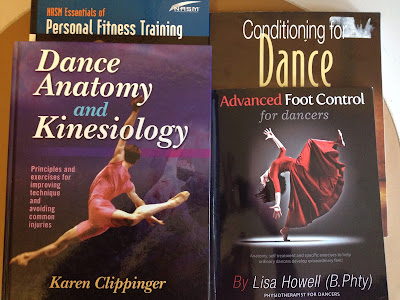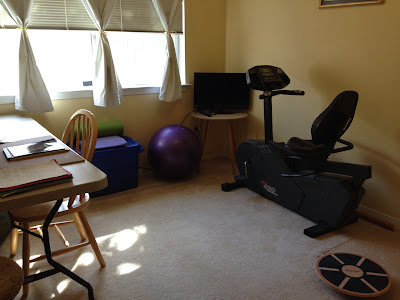 |
| A little light reading. |
"The present letter is a very long one, simply because I had no leisure to make it shorter."
Blaise Pascal
Several of you have noticed I'm taking longer to answer emails and I've been posting far less lately. My apologies, I dove into new projects thinking I would have time to keep everything updated and then clearly didn't have time.
Bits and pieces as fast as I can . . .
In short, I was inspired by several teachers - some I've met and studied with in person, others I've only corresponded with online, to pursue education in dance as physical therapy and dance medicine. This is a fairly well established field in other countries - but not so much here in the US. At least not widely. The field is huge and deciding where to focus has been difficult. So, informed by own experiences regaining strength and health through dance, I decided to focus on injury prevention and rehabilitation for dancers.
I am back in school - as a UT student taking Spanish (after all, eventually I will head back to Buenos Aires), and have also just finished my Posture Specialist Certification through National Posture Institute. The NPI certification required brushing up (read: retaking anatomy class online) on my anatomy and physiology. I've been away from the Sports Medicine field for almost 3 years now and it shows. To aid in that, I used UC Berkeley's very helpful Anatomy and Physiology class online (free). The entire certification took just about 2 months to complete.
Now that the NPI certification is done, it's on to the Personal Training Certification with a focus on Exercise Therapy. Initially I will be going through National Association of Sports Medicine - mostly because it's widely transferable and recognized, but also because I managed to get the study materials for a tenth the price they sell it online. Yay! Specializations will likely come from other organizations such as American Council on Exercise (ACE). I hope to have the NASM certification done by this Summer. After that the more specialized studying starts.
I'm a little tired just writing all of that . . yeesshh..
What started all of this, you might ask?
A conversation.
Isn't it always a conversation?
A little history . . .
I was sharing my experience with another dancer (a beginner) who said that tango didn't seem to require much exertion. She was wondering if she was going to derive any physical benefits from a dance that seemed so tame compared to salsa and swing. So I told her my story - the shortened version follows.
In the 3 years prior to me starting tango, I had lost half an inch of my height. My doctor explained that between scar tissue forming in my abdomen from endometriosis and pain in my muscles generally, I was starting to stoop slightly. I could no longer hold myself completely upright without pain. She also told me that due to my increasing instability, I might need to consider using a cane. She had no answers for me - only observations of my body that was starting to become alien to me.
On the advice of my grandmother, I changed doctors to an Osteopath and started taking tango lessons.
Fast forward - just under a year later, I got my half inch back. I never needed to get the cane. According to my doctor's physical therapy assessments, my posture had changed significantly. I was having flare-ups every couple of weeks instead of every day. And when I do have a flare-up, they don't last as long.
As all of this happened, I started talking to other people locally about their experiences - and then reached out through Facebook, Twitter and my blog to get other peoples' stories. They poured in. I was far from the only one. I sought out doctors and teachers to learn more. I went to Buenos Aires and learned even more. When I got back from Argentina, I looked for dance physiotherapists for guidance on more formalized training - and that has brought me to this point.
 |
| Half of the new therapy/training room my husband and I set up in our house. |
Personal Training and Rehabilitation for Dancers
In the United States education in this field is not as universally organized - some universities have solid programs in dance medicine, but most do not. The people that I know in the field, in the US and in other countries, have forged their own path and sought education from a variety of sources - which is now what I find myself doing. I'm working with my tango teacher, Daniela Arcuri, to get a picture of what is really needed in my own community, and with other teachers and mentors around the world to get an idea of what education is available and appropriate to the program I am trying to create.
Dance physiotherapists, personal trainers and teachers share three fundamental principles in building better dancers and preventing injuries - balance training, posture training and a focus on the quality of movement - not simply how many times a dancer is able to repeat the movement. And that is how I am building my own program and organizing my own education. Right now, thanks to my NPI education, I am able to perform posture, balance and alignment assessments and prescribe therapeutic exercise to address many postural issues. Currently, I am working to adapt those assessments and exercises to dancers' needs in particular.
 |
| Another challenge, trying to find time for my own training - almost to full demi-pointe on the wobble board.) |
I hope to have more updates soon, but for now - back to studying.
Thank you to so many of you have encouraged me in this path - this is going to be a quite a journey.
Comments
You might find interesting "Tecnicas para bailarinas" (Techniques for followers) by Maria Olivera, tangosalon.com.ar. It has a series of exercises that include posture, balance, walking, ochos, and decorations. I've found it challenging and productive.